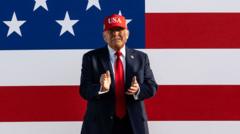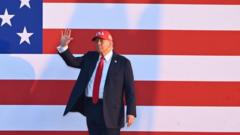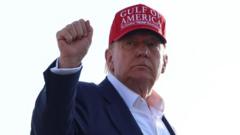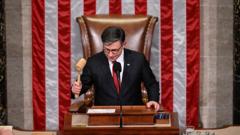In a marked development, China has engaged in tariff discussions with the United States, indicating a willingness to address trade tensions. However, many complexities remain, suggesting a lengthy negotiation process is still on the horizon.
China Hits Pause on Trade War Negotiations, But Challenges Remain

China Hits Pause on Trade War Negotiations, But Challenges Remain
Recent discussions between the US and China signal a shift in trade relations, yet obstacles persist.
China faced significant pressure from the escalating trade war initiated by former President Donald Trump, who imposed heavy tariffs on Chinese goods, prompting a firm "we will not back down" stance from Beijing. Observers noted a rise in nationalist sentiments within China, as state-run social media featured cartoons mocking America's position. Nevertheless, a two-day dialogue in Geneva between the two nations has opened new avenues for potential resolution.
US Treasury Secretary Scott Bessent highlighted that both sides share a desire to avoid a trade decoupling, emphasizing the need for continued commercial exchange. He characterized previous tariffs as akin to an embargo, detrimental to both economies. Economists welcomed the news, adjusting forecasts favorably—the tariffs will decrease from 50% to 30% on US goods and from 25% to 10% on Chinese imports, a compromise that some believed was unlikely.
The optimistic rhetoric from both sides marks a departure from earlier defiance. Trump described the discussions as a "total reset" on his social platform, while Chinese officials noted the agreement as a crucial step towards mending ties and fostering collaboration.
Yet, China's economic landscape remains precarious. An oncoming crisis related to real estate, along with rising unemployment and lackluster consumer spending, are growing concerns. The situation is exacerbated by recent declines in China's consumer price index, the third consecutive month of negative growth, indicating restrained spending and heightened competition among businesses.
The Chinese Commerce Ministry affirmed the agreement serves as a foundation for future cooperation, but also issued a pointed reminder to the US about correcting unilateral tariff increases. Meanwhile, state media has warned that China’s patience is not limitless, stressing the need for respect and reciprocity in negotiations.
Experts emphasize that while this development marks a temporary triumph, the underlying issues governing trade disparities—like substantial trade imbalances and industry-specific challenges—remain unresolved. This "reprieve" is fleeting, only providing a pause as negotiations continue. The true test of stability and collaboration lies ahead, with the negotiations shifting from the factory floors and retail markets to the negotiation tables in Beijing and Washington—a clear indication that the complexities of US-China trade relations are far from settled.
US Treasury Secretary Scott Bessent highlighted that both sides share a desire to avoid a trade decoupling, emphasizing the need for continued commercial exchange. He characterized previous tariffs as akin to an embargo, detrimental to both economies. Economists welcomed the news, adjusting forecasts favorably—the tariffs will decrease from 50% to 30% on US goods and from 25% to 10% on Chinese imports, a compromise that some believed was unlikely.
The optimistic rhetoric from both sides marks a departure from earlier defiance. Trump described the discussions as a "total reset" on his social platform, while Chinese officials noted the agreement as a crucial step towards mending ties and fostering collaboration.
Yet, China's economic landscape remains precarious. An oncoming crisis related to real estate, along with rising unemployment and lackluster consumer spending, are growing concerns. The situation is exacerbated by recent declines in China's consumer price index, the third consecutive month of negative growth, indicating restrained spending and heightened competition among businesses.
The Chinese Commerce Ministry affirmed the agreement serves as a foundation for future cooperation, but also issued a pointed reminder to the US about correcting unilateral tariff increases. Meanwhile, state media has warned that China’s patience is not limitless, stressing the need for respect and reciprocity in negotiations.
Experts emphasize that while this development marks a temporary triumph, the underlying issues governing trade disparities—like substantial trade imbalances and industry-specific challenges—remain unresolved. This "reprieve" is fleeting, only providing a pause as negotiations continue. The true test of stability and collaboration lies ahead, with the negotiations shifting from the factory floors and retail markets to the negotiation tables in Beijing and Washington—a clear indication that the complexities of US-China trade relations are far from settled.





















